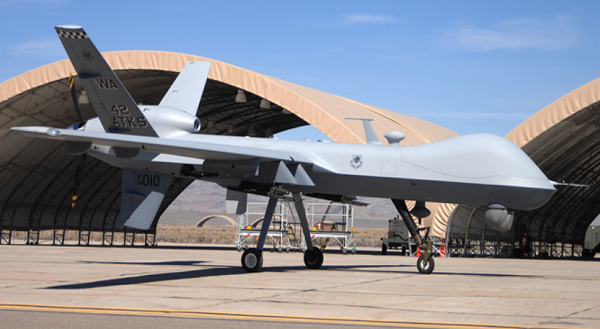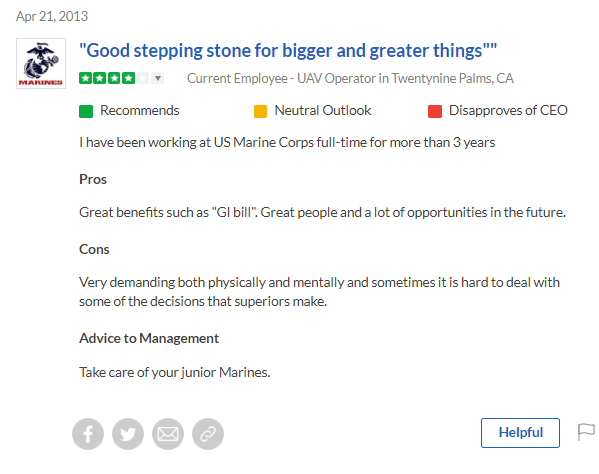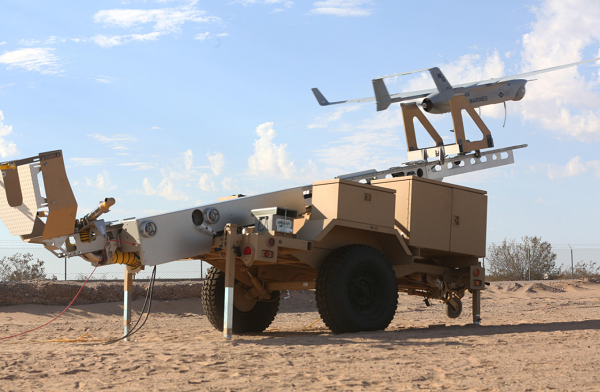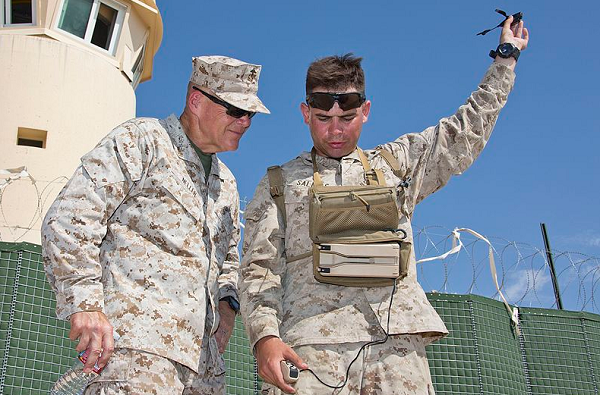A Marine Corps UAS Operator (MOS 7314) plans, coordinates, and integrates unmanned aircraft systems missions to support the MAGTF (Marine Air-Ground Task Force).
A UAS (Unmanned Aircraft System) Operator will remotely pilot the air vehicle.
Previously, this MOS was referred to as unmanned aerial vehicle (UAV) operations.
According to Unmanned Aircraft Systems Operations (MCRP 3-20.5), in 2008 UAV operations changed to UAS because the UAV system is only one component of the entire system.
Related Article – Marine Corps MOS List: Details on all 125 USMC Jobs
Qualifications and Training
Those who wish to enter into this MOS must possess a General Technical score of at least 110 (non-waiver eligible) on the ASVAB.
Interested recruits will also require a Secret security clearance, as well as normal color vision.
Recruits must be 17-28 years old, have a high school diploma, be a U.S. citizen, and meet the height, weight, and body fat requirements.
This MOS requires passing a class IV flight physical per the Manual of Naval Medical Depart, section IV, Article 15-100.
Recruits will attend the Marine Corps Recruit Depot Parris Island or Marine Corps Recruit Depot San Diego.
The coursework consists of completing the Unmanned Aircraft Systems Operator Common Core Course using one of the following paths:
RQ-21: Complete the UAS RQ-21 Aerial Vehicle Operator course at MCAS Cherry Point, NC.
MQ-9: Complete formal training at the USAF Remotely Piloted Aircraft Course Basic Sensor Operator School at Randolph AFB, TX, and the USAF MQ-9 Enlisted Course Initial Qualification Training (IQT) at Holloman AFB, NM.
Related Article –Army Unmanned Aerial Vehicle (UAV) Operator (MOS 15W)
What does a Marine UAS Operator do?

Unmanned Aircraft have been around since World War I, and advances in technology have led to their use in major combat and contingency operations today.
UASs are usually recovered and reused after each mission.
Unmanned aircraft consist of rotary-wing, fixed-wing, or lighter-than-air vehicles and can be controlled by line-of-sight or beyond-line-of-sight communications.
Each unmanned aircraft has different payloads that change the performance options of the aircraft.
Payloads are the sensors, relays, and weapons (lethal and non-lethal) that can be on the aircraft.
The UAS Operator is involved with mission planning, payload control, and communication procedures.
They are located at the ground control station (GCS).
Ground control stations can be anything from a laptop computer to a van or fixed facility.
UAS Operators control the launch, navigation, and recovery of the aircraft.
They will operate payloads using optical sensors including electro-optical, laser marking, laser targeting, and infrared.
Operators conduct call-for-fire to construct indirect fire missions and deliver both direct and indirect fires.
The UAS Operators are part of the aircrew and will remotely pilot the vehicle.
They execute remote video terminal operations.
UAS Operators use laser marking and targeting systems.
Operators will also prepare mission reports.
They are required to use techniques and procedures in the performance of terminal guidance operations.
UAS Operators are divided into groups based on the UAS assets they cover:
- Groups 1 and 2-Unmanned Aerial Vehicles less than 55 pounds and fly below 3,500 feet
- Group 3- Unmanned Aerial Vehicles up to 1,320 and fly up to 18,000 feet.
- Group 4- Unmanned Aerial Vehicles more than 1,320 pounds and above 18,000 feet.
- Group 5-Heavier and higher Unmanned Aerial Vehicles than Group 4 with the ability to stay in the air longer with higher payloads.
UAS Operators aim to enhance intelligence, surveillance, and reconnaissance (ISR) capabilities.
What does a Marine UAS Operator get paid?
UAS Operators are paid based on rank and time of service.
Without prior military experience, recruits can expect to make around $1,900 a month in base pay, with the amount increasing as training is completed and rank increases.
Base pay does not include benefits or other additional pay options.
The table below provides an outline for Marine Corps pay based on rank.
| Insignia | Pay Grade | Rank | Abbreviation | 2023 Minimum Monthly Pay |
|---|---|---|---|---|
| E-1 +4 months | Private | Pvt | $1,917.60 | |
| E-2 | Private First Class | PFC | $2,149.20 | |
| E-3 | Lance Corporal | LCpl | $2,259.90 | |
| E-4 | Corporal | Cpl | $2,503.50 | |
| E-5 | Sergeant | Sgt | $2,730.30 | |
| E-6 | Staff Sergeant | SSgt | $2,980.50 | |
| E-7 | Gunnery Sergeant | GySgt | $3,3445.80 | |
| E-8 | Master Sergeant | MSgt | $4,957.20 | |
| E-8 | First Sergeant | 1stSgt | $4,957.20 | |
| E-9 | Master Gunnery Sergeant | MGySgt | $6,055.50 | |
| E-9 | Sergeant Major | SgtMaj | $6,055.50 | |
| E-9 | Sergeant Major Of The Marine Corps | SgtMaj | $6,055.50 |
Benefits
Military benefits are generally noted as one of the positive attributes when looking at reviews.
The Marine Corps provides enlisted Marines with free housing, including utilities and maintenance. Meals and a clothing allowance are also included.
The Corps also provides both housing and subsistence allowances for marines authorized to live off base.
It also provides opportunities such as tuition assistance programs that allow most individuals to attend college for little to nothing out of pocket.
Other benefits include medical, dental, sick time, vacation, retirement, and low-cost life insurance.
Related Article –Marine Air Traffic Controller (MOS 7257): Career Details
Job Reviews
Most reviews rate the position 4/5 stars.
This MOS allows individuals to work with technology that is constantly advancing.
Working with new technology requires additional training, but also learning new, valuable skills.
This position can be challenging mentally but can be very interesting as well.
A review from a UAV Operator (UAS) can be found below.

Civilian Career Opportunities
Working as a UAS Operator provides skills in drone and avionics technology.
Related civilian careers include Aerospace Engineering and Operations Technicians, Aviation Analysts, Flight Engineers, and Electro-Mechanical Technicians.
Potential positions with the Department of Homeland Security are available using the skills learned in this MOS.
Marines can also take advantage of USMAP, which provides apprenticeship opportunities towards additional civilian careers.
Summary

A Marine Corps UAS Operator (MOS 7314) conducts unmanned aircraft system missions in support of MAGTF.
As part of Occupational Field 73, Navigators and Unmanned Aircraft System Officers/Operators, operators are considered aircrew members and remotely pilot vehicles.
Marines in this MOS must have a Secret security clearance and meet all physical/medical evaluation requirements.
Available reviews of this MOS rate it positively.
Civilian careers related to the skills learned can be found in avionics and technology.
Related Article –Marine Aviation Operations Specialist (MOS 7041): Career Details
References
- 5 Best Jobs for Female Marines - June 20, 2024
- 10 Best Marine Corps Recruiting Videos of All Time - June 20, 2024
- Marine Corps Requirements - June 20, 2024
Originally posted on November 25, 2019 @ 5:12 am
Affiliate Disclosure: This post may contain affiliate links. If you click and purchase, I may receive a small commission at no extra cost to you. I only recommend products I have personally vetted. Learn more.
